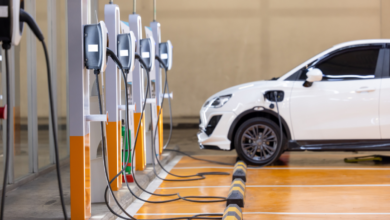Research finds electric cars are silent but violent for pedestrians • The Register

The road to net zero might be paved with good intentions, but it’s also apparently littered with injured pedestrians.
Researchers from the London School of Hygiene & Tropical Medicine have highlighted a worrying side effect of the electric vehicle revolution.
As a pedestrian, you are twice as likely to be injured by an electric or hybrid (E-HE) car than by one with an internal combustion engine (ICE), according to a paper published in the BMJ Journal of Epidemiology & Community Health, and three times more likely in cities and towns.
The paper says this is “consistent with the theory that E-HE vehicles are less audible to pedestrians in urban areas where background ambient noise levels are higher.”
The conclusion that “E-HE cars pose greater risk to pedestrians than ICE cars in urban environments” was reached based on analysis of 32 billion miles of battery-powered car travel and 3 trillion miles of petrol and diesel car journeys in Britain between 2013 and 2017.
During that period, there were 916,713 reported casualties from road traffic collisions. 120,197 of those were pedestrians, of which 96,285 had been hit by a car or taxi. 71,666 (74 percent) were hit by an ICE car and 1,652 (2 percent) by an E-HE car.
The difference is understandable seeing how ICE vehicles still make up the vast majority of cars on the roads, but after taking into account number of miles driven, the researchers found that electric and hybrid cars posed a much greater risk to pedestrians than ICE vehicles.
Pedestrian casualty rates per 100 million miles were 5.16 for E-HE vehicles and 2.40 for ICE vehicles. The results did not find that they were more dangerous in rural settings, but unearthed “strong evidence that E-HE vehicles were three times more dangerous than ICE vehicles in urban environments.”
As noted, the reason generally seems to be that electric vehicles are too stealthy. Pedestrians, accustomed to the growl of a traditional engine, are often blissfully unaware of the near-silent approach of an electric car. Imagine leisurely strolling across the street, headphones in, Taylor Swift blasting, only to be abruptly acquainted with the hood of a Prius.
“The risk must be mitigated as governments phase out petrol and diesel cars,” the paper states, and efforts have been made to address the issue. In 2019, the UK and EU implemented laws requiring electric cars to have a sound system operating below speeds of 20 km/h. Japan, China, and the United States also have similar regulations.
However, noise or lack thereof may not be the only contributing factor. Musing on areas of further research and unanswered questions, the researchers wrote: “If the braking distance of electric cars is longer, and electric cars are heavier than their petrol and diesel counterparts, these factors may increase the risks and the severity of injuries sustained by pedestrians and require investigation.”
They also suggested that drivers of electric vehicles may be younger than those of ICE vehicles, and wondered whether this might have any bearing on the alarming results.
“As car manufacturers continue to develop and equip new electric cars with Collision Avoidance Systems and Autonomous Emergency Braking to ensure automatic braking in cases where pedestrians or cyclists move into the path of an oncoming car, future research can repeat the analyses presented in this study to evaluate whether the risks of E-HE cars to pedestrians in urban areas have been sufficiently mitigated,” they added.
As we slap ourselves on the back for reducing emissions, let’s also remember to look both ways, listen carefully, and maybe, just maybe, we’ll avoid the pain and embarrassment of being run over by a car we never heard coming. ®



